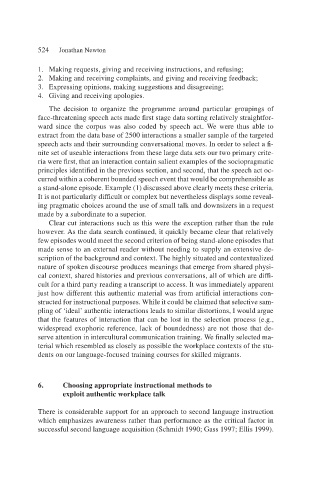Page 546 - Handbooks of Applied Linguistics Communication Competence Language and Communication Problems Practical Solutions
P. 546
524 Jonathan Newton
1. Making requests, giving and receiving instructions, and refusing;
2. Making and receiving complaints, and giving and receiving feedback;
3. Expressing opinions, making suggestions and disagreeing;
4. Giving and receiving apologies.
The decision to organize the programme around particular groupings of
face-threatening speech acts made first stage data sorting relatively straightfor-
ward since the corpus was also coded by speech act. We were thus able to
extract from the data base of 2500 interactions a smaller sample of the targeted
speech acts and their surrounding conversational moves. In order to select a fi-
nite set of useable interactions from these large data sets our two primary crite-
ria were first, that an interaction contain salient examples of the sociopragmatic
principles identified in the previous section, and second, that the speech act oc-
curred within a coherent bounded speech event that would be comprehensible as
a stand-alone episode. Example (1) discussed above clearly meets these criteria.
It is not particularly difficult or complex but nevertheless displays some reveal-
ing pragmatic choices around the use of small talk and downsizers in a request
made by a subordinate to a superior.
Clear cut interactions such as this were the exception rather than the rule
however. As the data search continued, it quickly became clear that relatively
few episodes would meet the second criterion of being stand-alone episodes that
made sense to an external reader without needing to supply an extensive de-
scription of the background and context. The highly situated and contextualized
nature of spoken discourse produces meanings that emerge from shared physi-
cal context, shared histories and previous conversations, all of which are diffi-
cult for a third party reading a transcript to access. It was immediately apparent
just how different this authentic material was from artificial interactions con-
structed for instructional purposes. While it could be claimed that selective sam-
pling of ‘ideal’ authentic interactions leads to similar distortions, I would argue
that the features of interaction that can be lost in the selection process (e.g.,
widespread exophoric reference, lack of boundedness) are not those that de-
serve attention in intercultural communication training. We finally selected ma-
terial which resembled as closely as possible the workplace contexts of the stu-
dents on our language-focused training courses for skilled migrants.
6. Choosing appropriate instructional methods to
exploit authentic workplace talk
There is considerable support for an approach to second language instruction
which emphasizes awareness rather than performance as the critical factor in
successful second language acquisition (Schmidt 1990; Gass 1997; Ellis 1999).

